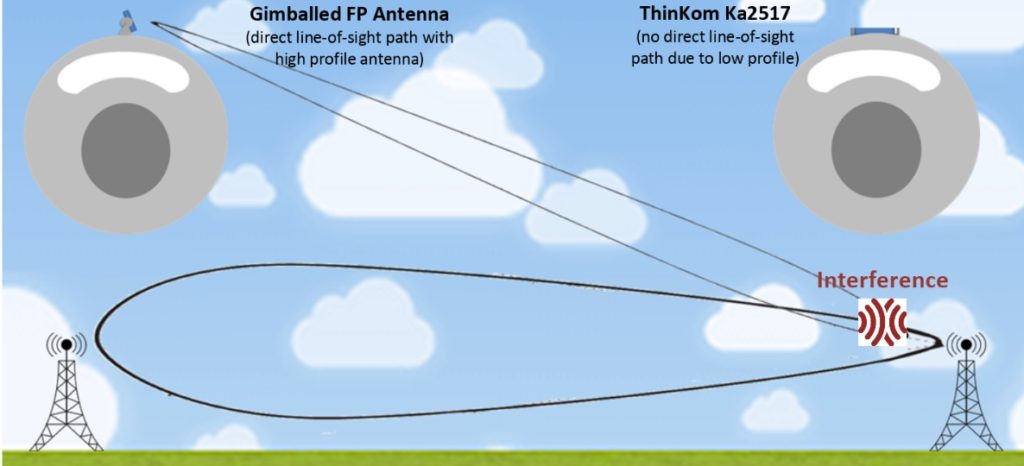Last fall at the World Radiocommunication Conference 2019 (WRC-19), a key international pact was inked by ITU member states, opening up more Ka-band spectrum for mobile satellite solutions. The treaty, which ensures that Earth Stations in Motion (ESIM) can access the full Ka-band spectrum, was applauded by multiple Ka-band satellite operators.
Viasat lauded the agreement, saying in a press release at the time that it provides access to “four times” more global Ka-band spectrum for satellite-powered aviation and maritime broadband connectivity. “Having a uniform regulatory framework for ESIM applications across nations will enable Viasat to meet escalating customer requirements for mobility service enhancements, while creating a broader environment for further innovation in the mobility sector,” said chairman and CEO Mark Dankberg.
In a statement provided to Runway Girl Network, Inmarsat said: “The outcome of WRC-19 was positive, especially with the expansion of Ka-band frequencies for Earth stations in motion (ESIM), which will facilitate further growth in satellite connected mobility. Inmarsat is already investing in new generations of satellites – one was launched shortly after WRC-19 concluded, with seven more scheduled to launch in the coming four years – to deliver for our customers worldwide and to enable advantage to be taken of the new ESIM rules.”
Hughes also weighed in, telling RGN that it sees WRC-19 as a “positive” for the firm. “Besides the increased certainty for ESIMs in the K band, we were also successful at obtaining access to 1 GHz of additional spectrum for the fixed satellite service and in the bands above 24 GHz that were identified with IMT but shared with satellite. We received the protections we need.”
There are clear reasons to cheer that basic Ka-bands (19.7-20.2 GHz RX and 29.5-30.0 GHz TX) will be augmented with “new” Ka-bands (17.7-19.7 GHz RX and 27.5-29.5 GHz TX), the latter of which are four times the bandwidth of the former. But it is also true that with greater bandwidth comes greater interference responsibility in aero, including a requirement to protect terrestrial 5G users from interference.
WRC agreements require that Ka satcom users, both on the ground and in the air, must not interfere with Terrestrial PTP systems sharing the same 27.5-29.5 GHz frequencies. This protected band is referred to as “Band n257”.
According to ThinKom chairman and CTO Bill Milroy, gimbaled flat plate antennas in aero are challenged by this stipulation, due to the unavoidable direct line-of-sight path between the ground and their high-profile apertures.
Specifically, the aero ESIM requirement (protection of terrestrial 5G users from interference from aero terminals when operating on GSOs and NGSOs) and Article 22 (protection of GSO satellites from interference from aero terminals when operating on NGSOs) are going to be new challenges for gimbaled flat-plate antennas, as well as electronically steered antennas (ESAs), he suggested. That will be particularly true as the skies become more and more crowded with multiple LEOs and GEOs, and with terrestrial users (in many countries, including the US, Canada, South Korea, Japan, India,) all vying for and sharing the same Ka frequencies, he added.
ThinKom sees its Ka aero antenna hardware as uniquely positioned to operate under the new paradigm, as the radiating aperture for its VICTS/phased array antenna is recessed into a metal shielded housing and always crown-mounted, so it is flat and hidden from the horizon as well as areas below the horizon. In short, there are no direct paths (from the horizon or the ground) to ThinKom’s Ka2517-branded antenna.
“There are a lot of smart people working for our competitors [in the antenna hardware space] and so it’s a known problem so I’m sure that they’re busily working away on how to address this issue, whether it’s through frequency management or actually improving the quality of the antennas. But we like to think we have a really big head start on that,” Milroy told RGN earlier this year at the APEX TECH conference in Los Angeles.
In a statement issued today, Milroy said: “Our VICTS phased-array technology ensures full compliance with ITU Article 22 by eliminating elevated sidelobes when operating on NGSOs, thereby protecting against interference in the GSO plane.”
He added: “We have successfully completed numerous trials to demonstrate interoperability between NGSO and GSO satellites with no interference.”
The extent of potential overlap areas affected by the WRC-19 regulations will be significant, according to ThinKom.
It will be interesting to see how things play out in the coming months, especially for NGSO constellations/services that will be using some or all of the same Ka-bands (17.7-19.7 and 27.5-29.5 GHz.), including, noted Milroy, SES’s O3b constellation, SES’s mPower, Telesat’s planned LEO constellation, and Amazon’s Kuiper constellation.
Along with GSOs from Viasat, Inmarsat, and Hughes, these NGSOs (which will not be confined to the GSO plane, but instead will be “everywhere in the sky”, vying for the same Ka frequency bands) are going to require complex management and coordination, even as the needs and demands of terrestrial users in the same bands will have to be honored, he said.













